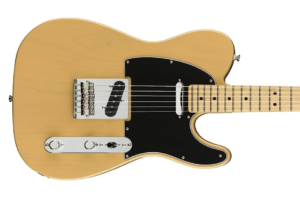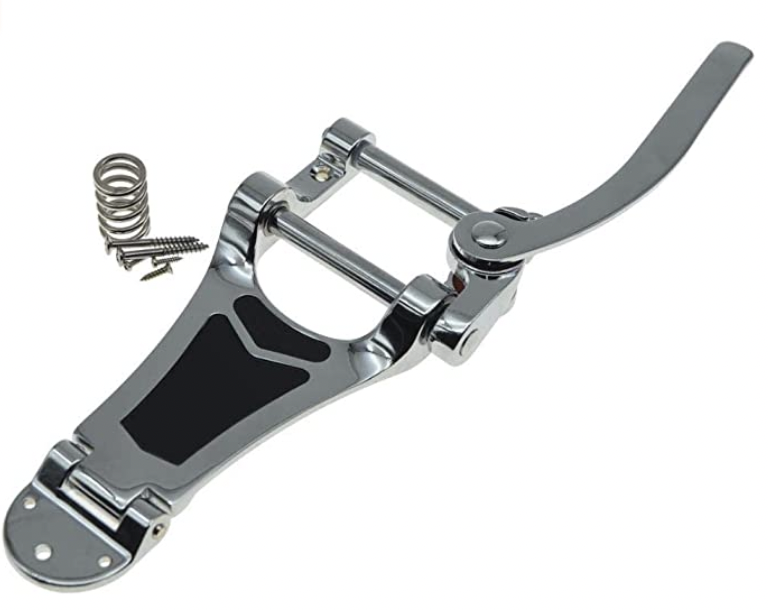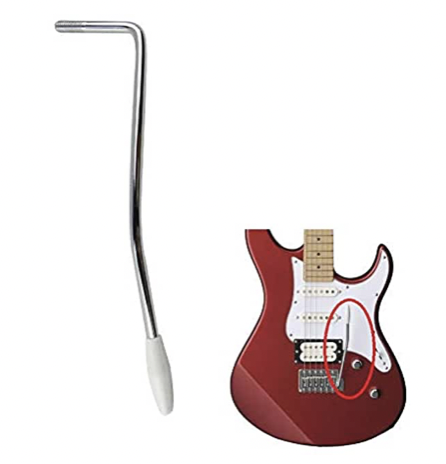A whammy bar, also known as a tremolo arm or vibrato arm, is a lever attached to the bridge of an electric guitar or some electric bass guitars. It is designed to manipulate the pitch of the strings by altering the tension on them, resulting in pitch bends, vibrato, and other expressive effects.
 When the whammy bar is pressed down or pulled up, it causes the bridge to pivot, which changes the tension on the strings. This action results in the pitch of the notes being raised or lowered, depending on the direction the bar is moved. By manipulating the whammy bar, guitarists can create various pitch modulation effects, such as dive bombs, upward or downward bends, wide vibrato, and subtle pitch variations.
When the whammy bar is pressed down or pulled up, it causes the bridge to pivot, which changes the tension on the strings. This action results in the pitch of the notes being raised or lowered, depending on the direction the bar is moved. By manipulating the whammy bar, guitarists can create various pitch modulation effects, such as dive bombs, upward or downward bends, wide vibrato, and subtle pitch variations.
The whammy bar is particularly associated with electric guitars equipped with a floating tremolo system, such as the Fender Stratocaster or Floyd Rose systems. These systems allow for both up and down pitch bending, providing a wide range of expressive possibilities. Some guitars also feature locking systems that help stabilize tuning and maintain string tension when using the whammy bar aggressively.
The whammy bar has been popularized by many guitarists across different genres, from Jimi Hendrix’s iconic use of dive bombs to Eddie Van Halen’s innovative tapping techniques. It adds a unique and dynamic element to the guitar’s sound, allowing players to infuse their playing with expressive pitch variations and create a distinctive playing style.
Most electric guitars have a whammy bar. Their goal is to simplify the creation of vibrato effects, where the string pitch is changed up and down slightly.
Also Read:
Donner Arena 2000 Multi Effects Pedal
TONEX AI machine Amp modeling Pedal
Eventide H90 MAX Harmonizer Multi Effects Pedal review
6 of the Best Guitar pedal power Supplies
12 Best Electric Guitar Strings
Starfire: Semi-Hollow Electric Guitar
Whammy Bar Models
Here are some models:
Here are some popular whammy bar models commonly found on electric guitars:
- Fender Standard Stratocaster Tremolo Bar: This is the whammy bar designed for Fender Stratocaster guitars. It features a threaded end that screws into the bridge plate of the guitar and provides smooth pitch bending and vibrato effects.
- Floyd Rose Original Tremolo System: The Floyd Rose system is a double-locking tremolo system known for its stability and ability to perform extreme pitch bends. It is often used by guitarists who require precise tuning stability and aggressive whammy bar techniques.
- Bigsby Vibrato Tailpiece: The Bigsby vibrato tailpiece is a classic design commonly found on hollow-body and semi-hollow guitars. It features a unique rocking arm that allows for subtle pitch modulation and vintage-style vibrato effects.
- Wilkinson/Gotoh Vintage-Style Tremolo: This tremolo system is commonly used on guitars that aim to replicate the vintage Stratocaster sound. It provides smooth pitch bending and moderate vibrato effects while maintaining good tuning stability.
- Kahler Tremolo System: The Kahler tremolo system is known for its innovative design and stability. It features a cam-driven mechanism that allows for precise pitch control and smooth operation, making it popular among guitarists who require accurate and expressive whammy bar techniques.
- PRS Patented Tremolo System: PRS guitars come equipped with their own patented tremolo system. It offers smooth and balanced pitch bending, and the bridge design helps maintain tuning stability even with aggressive whammy bar use.
- Ibanez Edge Tremolo System: The Ibanez Edge tremolo system is highly regarded for its stability and precise tuning capabilities. It is often found on Ibanez electric guitars and is favored by guitarists who require fast and precise whammy bar techniques.
The Vibrato Effect
Vibrato is a common effect using in music with distinct instruments. For example, violinists will perform vibrato by slightly moving their fingers up and down the neck of the instrument.
The vibrato effect is very useful to create longer and more interesting sounding notes. A long note without vibrato effect may sound to unnatural and flat. A note with vibrato seems for warm and interesting.
Creating Vibrato on a Guitar
Guitar players frequently employ the vibrato, but on acoustic instruments players to vibrato manually.
The easiest way to create vibrato is to quickly move your finger on the fretboard. This will generate pitch changes that sound as a vibrato.
Quick lateral changes or vertical movements on the string generate the effect of manual vibrato. Both ways will work, but will sound a little different. A good guitar player needs to master both ways of creating vibrato.
The Whammy Bar
With electric guitars and steel strings, it is a little more difficult to perform vibrato… The strings are heavier than nylon strings, which makes the vibrato less effective.
For this reason, electric guitars introduced whammy bars to make this easier.
A whammy bar is essencially a metal bar attached to the bridge, which makes it move up and down and change the string pitch.
Whammy Bar Models
There are several models of whammy bars in the market, which depend on the type of bridge used.
For example, Stratocaster guitars have a bridge that is ballanced by a system of springs. This complex bridge makes the whammy bar really simple: it is just a simple metal piece attached directly to the bridge.
Other guitars need more complex ways to perform the same function.
Vibrato and Tremolo
Whammy bar is another name for tremolo bars. This is a kind of misnomer, because a whammy bar creates a vibrato effect, not tremolo.
The vibrato effect is a small change in pitch, up and down. The tremolo effect, instead, is a quick volume change, up and down. This can be done using a guitar pedal or amp that provides this effect.
Although tremolo is not the correct word, you will sometimes find it as the word to describe the whammy bar as a tremolo bar.
How to Use a Whammy Bar
Using a whammy bar, also known as a tremolo arm or vibrato arm, can add expressive effects and pitch modulation to your guitar playing. Here’s a step-by-step guide on how to use a whammy bar effectively:
- Familiarize Yourself : Take a moment to understand the construction and mechanics of your guitar’s whammy bar. It is typically located near the bridge of the guitar and can be moved up or down.
- Proper Installation: Ensure that the bar is properly installed and secure. Depending on your guitar model, it may need to be screwed in or inserted into the bridge mechanism. Make sure it is firmly in place before use.
- Palm Positioning: Rest the palm of your hand lightly on the bridge to provide stability while using the bar. This will help you control the movement and prevent excessive unwanted vibrations.
- Downward Pitch Bends: To perform a downward pitch bend, push the whammy bar towards the guitar body. Start with gentle movements and gradually increase the depth and speed to achieve the desired effect. This technique is commonly used for creating dive bombs or dramatic pitch drops.
- Upward Pitch Bends: To perform an upward pitch bend, pull the whammy bar away from the guitar body. Similarly, start with subtle movements and gradually increase the depth and speed. Upward pitch bends can add tension and excitement to your playing.
- Vibrato and Modulation: Use small, controlled movements of the whammy bar to create vibrato effects. Rock the bar back and forth to produce subtle pitch variations that add character and expression to your playing. Experiment with different speeds and depths to find your desired vibrato style.
- Return to Neutral Position: After using it, allow it to return to its neutral position. This will bring the strings back to their original pitch. Releasing the whammy bar slowly can create a smooth transition, while releasing it quickly can produce a snappy effect.
- Practice Control and Precision: It takes practice to develop control and precision. Start by experimenting with simple pitch bends and vibrato, gradually incorporating them into your playing style. Focus on achieving smooth and accurate movements to maintain control over the pitch changes.


